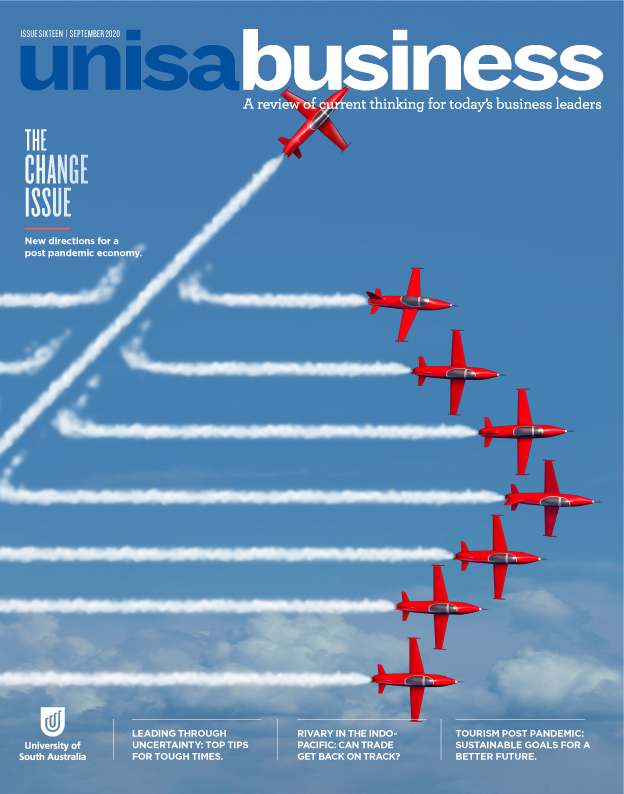01 September 2020
Authors: Dr Sukhbir Sandhu & Professor Carol T Kulik
Saving the planet in the midst of a pandemic is a tough gig. But when you’re the organisation’s Sustainability Manager, it’s right in your remit. Here, Dr Sukhbir Sandhu and Professor Carol T Kulik from UniSA’s Centre for Workplace Excellence share advice about how to pack a punch on sustainability efforts, even in lockdown.
When the coronavirus pandemic forced people to hit pause on their usual activities, planet Earth launched into some heavy-duty housekeeping. In New Delhi, one of the most polluted cities in the world, levels of the harmful gas nitrogen dioxide fell by more than 70 per cent; the water in Venice’s canals turned crystal-clear for the first time in living memory; and global industrial greenhouse gas emissions between April 2019-20 dropped by 17 per cent. COVID-19 even made the world a little quieter, as measured by the planet’s seismic noise.
Such environmental changes attest to the planet’s resilience and ability to heal. But the benefits are fragile. Preserving the gains and building on their momentum requires ongoing commitment and attention. No one understands these long-run challenges better than sustainability managers.
Sustainability managers are the change agents responsible for surfacing sustainability issues in organisations, launching sustainability initiatives, and ensuring that other functions (such as production, marketing, supply chain) change their polices and structures to implement these initiatives.
In our research, we’ve talked with dozens of sustainability managers. We’ve admired their passion for the environment, but we’ve also felt their pain as they described the frustrations they encounter in their roles. Their experiences are dynamic: the nature of their challenges changes over the course of an organisation’s sustainability journey, and so too do their strategies for impacting organisational change.
Here’s Jessica’s story. Jessica is a prototype based on the sustainability managers that we talked to for our research. We use ‘her story’ to illustrate three of the most common challenges experienced by sustainability managers. Jessica’s concerns naturally focus specifically on sustainability, but the experiences will resonate with change agents of all kinds – anyone whose role makes them responsible for an organisation’s wider impact on society (organisational diversity and inclusion, public health, social equality) alongside financial indicators of organisational success.
The strategies we recommend here for creating meaningful impact on sustainability issues may inspire other change agents within organisations.
Challenge 1: A lack of role clarity
 My colleagues have no idea what I do! How do I even start creating change?
My colleagues have no idea what I do! How do I even start creating change?
Advice: When organisations first start on their sustainability journey, many of them do not have a clear plan. They hire a sustainability manager (often just to be seen doing the right thing) but the role might be marginalised and poorly understood (both by the sustainability manager who occupies it and by their organisational colleagues). During these initial years, sustainability managers are unlikely to be part of the senior decision-making group, making change difficult and often out of reach.
So, what do you do? Well, the starting point is for sustainability managers to develop clarity around their roles and employ purposeful strategies to make their voices heard.
Let’s see this in action: We met Jessica soon after she was hired as a sustainability manager in a mid-sized mining company. Jessica is her organisation’s first sustainability manager, and so there is no blueprint for her job. Jessica is rather fuzzy on the details of her role and she struggles to explain her responsibilities to colleagues. Her situation is frustrating at the moment, but Jessica can transform the uncertainty into opportunity if she engages in some proactive job crafting - the deliberate shaping of a job to match both the nature of the job and the needs of the worker.
By systematically analysing the social and environmental issues that pose the most risk to her organisation (‘identifying materiality’), Jessica can get a clear sense of the high-risk issues and develop an action plan to address these risks (as well as highlighting the costs of not addressing them). She can then present this risk analysis formally to top management.
This proactive approach to identifying sustainability issues that are salient for the organisation, and developing plans to address them, will help Jessica shape the contours of her role and its responsibilities (‘this is what I do’). Most boards and senior managers understand risk language, so this systematic, solution-focused approach is likely to have traction in Jessica’s organisation (‘my voice is heard’).
But, what about Jessica’s peers? To ensure that her colleagues understand what her job entails, Jessica needs to get involved and to collaborate with other roles in the organisation. She can start by leveraging organisational communication channels (such as an internal newsletter), then extending her reach across an internal sustainability committee. These activities will keep sustainability front and centre in the minds of organisational members.
Challenge 2: Data fatigue

My stats are compelling, so why do their eyes glaze over?
Advice: Strategies that successfully draw attention to environmental and social change in the first few years of an organisation’s sustainability journey can lose their oomph as time goes by. Using numbers and statistics to highlight the risks that environmental degradation and climate change pose to an organisation is a useful ‘foot in the door’ strategy, giving sustainability managers the hard numbers for change credibility. But, once decision-makers understand the risks, presenting more data is not always effective. Over time, people gradually desensitise to arguments that rely solely on doom and gloom statistics, so in this scenario, our advice is to balance the number delivery with storytelling; people relate to stories.
We caught up again with Jessica after she had been in her role for a couple of years. At this point, Jessica had successfully focused her organisation’s attention to push for change on a few key environmental and social risks. Now, she wanted to highlight the more intricate (and long-term) impacts of her organisation’s mining operations on the local Indigenous communities.
We suggested that Jessica invite Aboriginal representatives to organisational meetings (with advance notice and buy-in from all parties). Jessica can facilitate these meetings so that the Aboriginal stakeholders have an opportunity to share their experiences and explain how mining activities are changing their way of life. Their personal stories can initiate meaningful conversations about how the mining company might reduce its impact on the land and increase benefits to the community (for example, by offering training to help local employment).
As an organisation’s sustainability commitment matures, managers responsible for these change initiatives may need to go beyond data. Purposeful storytelling enables sustainability managers to target minds and hearts, so that organisations can move beyond managing stakeholders to meaningfully engaging stakeholders.
Challenge 3: Wider impact

I want bigger change and I want it now!
Advice: Real sustainability change needs collective action and a long-term focus. That means building and nurturing relationships across organisational boundaries – with supply chain partners, with other organisations in the industry (and yes, sometimes even with an organisation’s competitors). The sheer scale and complexity of sustainability challenges can be daunting and overwhelming, even for people who are personally committed to the cause. On some days, it may feel far easier to just pretend that the problem does not exist.
Let’s check in on Jessica now. It’s been five years since she started as the sustainability manager at the mining company. She has clarity around her role (that proactive job crafting really paid off); she’s been able to get clear support from the top management and has a seat at the table; and she works closely with her colleagues in other divisions (production, marketing, human resources) to embed sustainability across these functions.
Jessica likes to joke that her role is like an octopus, with tentacles spread across all functions. She’s proud of what she’s achieved at her organisation, but she’s become increasingly aware that the positive actions of her organisation can have only a limited impact. Last year, Jessica joined the board of the National Mining Association, and she is using that position to advocate for government action on carbon pricing.
Over the years, Jessica has also recalibrated her understanding of competition. With the benefit of experience, Jessica now champions co-opetition (simultaneously competing in some areas and cooperating in other areas). She understands that her organisation competes with other mining companies in national and international markets in selling iron-ore, but she now has a heightened awareness that there are other areas in which mining companies can clearly cooperate. Setting industry standards to promote sustainability in the supply chain is one such area; sharing knowledge around mine rehabilitation – such as restoring ecosystems after the working life of a mine is over – is another.
Jessica is now actively choosing to cooperate with her counterparts in other companies to collectively address social and environmental challenges. There’s strength in numbers, and when the sector works together, they create faster and more fundamental positive change.
So, where have we landed?
At the start of this journey, we’ve demonstrated how change agents may need to engage in active job crafting as well as clearly communicating the business case for progressing the issues they want to champion. We’ve also advocated setting up cross-functional teams or committees quite early on to bolster change agents’ position and influence. Further along, we’ve shown how change agents will need to hone their storytelling skills. And finally, to continue to have meaningful impact, change agents must be prepared to go beyond their company’s boundaries and work with their counterparts in other organisations. This is the pathway to successful change.
Based on the authors’ article: ‘Shaping and being shaped: How organizational structure and managerial discretion co-evolve in new managerial roles’, Administrative Science Quarterly, vol. 64, no. 3, pp. 619-658.
Related content was published by the Network for Business Sustainability here.




